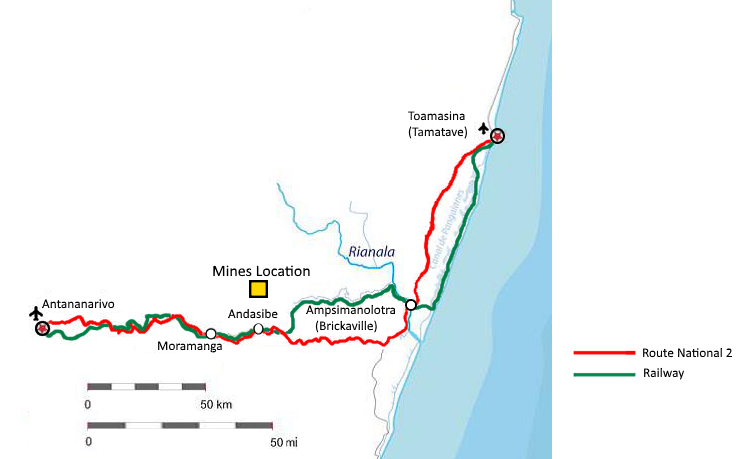Background
Graphite mining has taken place in the region of Lion’s holdings for over a century and specifically on Lion’s current mining permits for over 20 years. However, to date the methods used have been basic which has limited the output capacity but which also means that the majority of originally in-place reserves are expected to remain. Lion is preparing to implement a mining development plan that will boost the production rate using modern mining methods.
The graphite on Lion’s licenses is a high quality flake graphite that is suitable for use in fuel cells, as well as in traditional industrial applications.
Access and Logistics
Access to Lion’s permits is facilitated by the proximity of the permits to the major highway (Route Nationale 2) that runs from the capital city, Antananarivo, to the major east coast port of Toamasina (a.k.a. Tamatave). A railway also follows this route and historically a dedicated spur onto that railway was used to transport graphite from the mines in the region of Lion’s permits to Toamasina.

Mine Development Plan
Lion is currently preparing a mine development plan to get the existing mines which are currently on care and maintenance back into commercial production and to evaluate and develop other prospective areas on its permits. As part of the Mine Development Plan, Lion is undertaking environmental and social impact studies for the restarted mines.
Overview of the Mines
Lion holds three mining exploitation licenses totalling 4,375 hectares (10,811 acres) in the Ambato-Arana area where graphite has been produced for over a century. The production to date has been free digging of lateritic ore and open pit mining, providing low cost exploitation without need for blasting. The licenses are in the vicinity of Andasibe in Toamasina Province in Madagascar, 20 km to the northeast of Sheritt’s Ambatovy nickel/cobalt laterite open pit mine, and 200km via road from the seaport of Toamasina, Madagascar’s main port
Much of the mining infrastructure for the existing mines remains in good condition. Exposed graphite-bearing layers are as much as 10m in thickness in exposed laterite faces of up to 20m and even 30m in thickness. Lion’s geological analysis suggests that the graphite-bearing layers may be folded giving Lion additional graphite targets in the vertical dimension as well as horizontally due to extension of the graphite bearing layers beyond the current pits.
Historically, its mining permit in the Tsanavoniany area alone has produced 95% Carbon flake graphite at a steady annual rate of an estimated 2500 metric tons/year (mesh 80+) using less intensive techniques tan Lion intends to employ. The other two permits have produced graphite at an average annual rate of about 600 metric tons/year with similar carbon content and again using less intensive techniques tan Lion intends to employ.
Looking ahead, Lion is confident that only a minority of resources has been exploited thus far and that significantly higher production rates can be sustained on the existing mines by using modern techniques while additional resources are proven and prepared for development elsewhere on Lion’s permits. Lion is focused on returning its existing mines to production in 2020.
Social and Environmental Responsibility
Lion takes its social and environmental responsibilities very seriously. We are dedicated to capacity building and knowledge transfer, to supporting sustainable development and environmentally sensitive behaviour and to working with select relevant NGOs. Lion is committed to equal opportunities and to the ISO26000 corporate social responsibility (CSR) standard.


